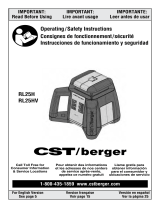
*2179602*
2179602 English 3
Retain all safety precautions and instructions for future reference. The term “electric tool” used in the
safety instructions refers to your mains-operated (corded) electric tool or battery-operated (cordless) electric
tool.
2.2 General safety measures
▶ Stay alert, watch what you are doing and use common sense when operating a power tool. Do not
use a power tool while you are tired or under the influence of drugs, alcohol or medication. A moment of
inattention while operating the power tool can result in serious personal injury.
▶ Do not render safety devices ineffective and do not remove information and warning notices.
▶ Keep children well away from laser devices.
▶ Laser radiation in excess of Class 2 may be emitted if the device is opened without following the correct
procedures. Have the device repaired only by Hilti Service.
▶ Project laser beams well above or well below eye height.
▶ Take the influences of the surrounding area into account. Do not use the device where there is a
risk of fire or explosion.
▶ Statement in accordance with FCC §15.21: Changes or modifications not expressly approved by Hilti
can restrict the user’s authorization to operate the equipment.
▶ You must check the accuracy of the device after it has been dropped or subjected to other
mechanical stresses.
▶ When the device is brought into a warm environment from very cold conditions, or vice-versa,
allow it to become acclimatized before use.
▶ When using adapters or accessories, make sure that the equipment is securely mounted.
▶ Keep the laser aperture clean to avoid measurement errors.
▶ The device is designed for the tough conditions of jobsite use, but as with other optical and
electronic instruments (e.g. binoculars, spectacles, cameras) it must be handled with care.
▶ The device is protected to prevent the ingress of moisture, but you must always wipe it dry before
stowing it in the transport container.
▶ Check the device before using it for important measuring work.
▶ Repeatedly check accuracy while using the device.
▶ Make sure that the workplace is well lit.
▶ Do not expose the laser to rain or wet conditions.
▶ Do not touch the contacts.
▶ Maintain the device carefully. Check that moving parts are in full working order and do not jam
and make sure there are no parts that are broken or damaged in such a way as to impair operation
of the device. If it damaged, have the device repaired before use. Many accidents are caused by
poorly maintained equipment.
2.3 Proper preparation of the working area
▶ Secure the area in which you will be taking measurements. Make sure that the laser beam is not
directed toward other persons or toward yourself while setting up the laser tool.
▶ Avoid unfavorable body positions when working from ladders. Make sure you work from a safe
stance and stay in balance at all times.
▶ Readings taken in the vicinity of reflective objects or surfaces, through panes of glass or similar materials
may produce incorrect results.
▶ Ensure that the tool is set up on a stable, level surface (not subject to vibration).
▶ Use the tool only within its specified limits.
▶ Use the tool and its accessories etc. in accordance with these instructions and in the manner
intended for the particular type of tool. Take the working conditions and the work to be performed
into account. Use of tools for applications different from those intended could result in a hazardous
situation.
▶ Use of the telescopic staff in the vicinity of overhead high voltage cables is not permissible.
2.4 Electromagnetic compatibility
Although the tool complies with the strict requirements of the applicable directives, Hilti cannot exclude the
following possibilities:




















